Did you know that a single roller coaster ride can trigger the release of endorphins comparable to those experienced during a skydiving freefall? Yes, amusement parks are not just about fun—they’re a full-blown sensory adventure!
In today's world, where stress levels are at an all-time high, amusement parks offer a much-needed escape. With their heart-pounding attractions and thrilling rides, they promise a rush that's hard to find elsewhere.

What if I told you that the design hacks used in creating these rides involve aerospace-level engineering and psychology, ensuring thrills at every second? Designers meticulously craft each loop and drop to maximize fear and delight. But that’s not even the wildest part…
The technology behind these rides is evolving faster than ever, integrating AI to customize each ride's experience based on real-time data. This leap doesn’t just personalize thrills but might revolutionize personalized entertainment. However, these dazzling advancements have a secret darker side…
Ever thought about how these high-speed rides affect your body? The gravitational forces experienced can sometimes be twice the intensity of a rocket launch, igniting debates among scientists and safety experts. What happens next shocked even the experts…
Many of us line up for hours just to experience a few minutes of sheer terror. But what drives this craving for amusement park rides? It’s more than a simple love for thrill—psychologists believe it’s deeply rooted in our physiology. Our body releases endorphins and dopamine, which are neurotransmitters that create euphoria akin to the effects of addictive substances. This natural high is what keeps thrill-seekers coming back. But there’s one more twist—cultural phenomena might play an even bigger role.
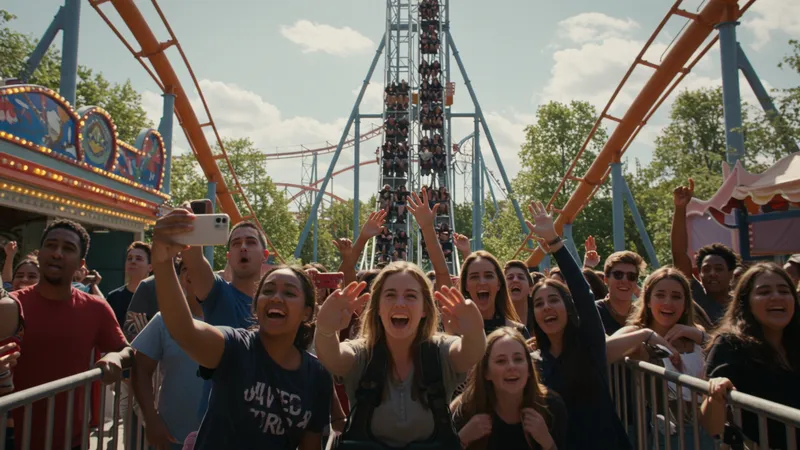
In many cultures, social status often ties into adventurousness. The braver you are on these rides, the cooler you seem among peers. This societal endorsement fuels a constant cycle of seeking the next best thrill. Unexpectedly, it’s less about the adrenaline and more about the bragging rights that follow. Social media platforms amplify this effect, as sharing ride experiences becomes a trend. But what you read next might change how you see these adventures forever—educational benefits are surprising everyone.
Amusement parks are not only havens for thrill-seekers; they’re also educational playgrounds. The physics behind roller coasters—like acceleration, gravitational forces, and energy transfer—can ignite a spark for science in young minds. Even history buffs find joy in themed parks that transport riders to different eras. This unexpected educational benefit complements their primary purpose—and there's more invention on the horizon.
The latest trend in amusement rides involves storytelling elements, turning each attraction into an immersive narrative experience. Imagine being part of a pirate adventure or a space odyssey, with the ride adapting to the storyline. This blend of thrilling physical experiences and engaging storytelling is drawing in crowds worldwide. But beyond the narratives, another element draws a deeper emotional response than ever predicted…
The genius behind creating roller coasters lies in a blend of art and science. Engineers use sophisticated computer simulations to craft rides that feel dangerously exhilarating but remain completely safe. The loops and twists are designed to manipulate gravitational forces perfectly, creating the illusion of defying gravity itself. These rides must endure rigorous testing far beyond what they’d experience in operation, yet it’s the human factor that challenges them the most. However, hidden challenges lurk behind the spectacle…

One lesser-known fact is the psychological engineering that goes into ride design. Experts meticulously consider color, sound, and motion to maximize the thrill factor. The suspense built as you ascend that first hill, followed by the exhilarating drop, is no accident. These elements play on psychological instincts of anticipation and relief, accentuating the ride’s impact. But beneath the ride’s thrilling façade emerges a more controversial debate among scientists and health experts.
Gravitational forces experienced on extreme rides can have varying effects on different individuals, prompting ongoing studies into what our bodies can handle. Some argue the need for more stringent controls, although enthusiasts insist on pushing these limits. This controversy fuels continuous innovation, sometimes involving groundbreaking propulsion technology, mimicking zero-gravity experiences. But such rapid innovation brings its challenges, especially when safety experts raise concerns..
The evolution of amusement rides continually adapts to technological advancements, such as virtual reality integrations, offering entirely new experiences. These rides are almost unrecognizable from their origins in both design and purpose, still bringing joy in fresh, unexpected ways. As we move towards interactive, AI-driven customization, there emerges an anticipated yet paradoxical struggle between creativity and caution. What lies ahead may redefine the industry entirely, but first, delving into visitor psychology reveals more…
Amusement parks are seizing insights from psychology to enhance visitor experiences, transforming simple attractions into dopamine-fueled joyrides. By understanding triggers for excitement and fear, designers craft spaces that delight from entrance to exit. The way pathways guide us toward rides, punctuated by ambient music and enticing aromas, encourages exploration and continuous engagement. It’s a seamless interplay of sensory cues that set the stage. Yet, more complex strategies lie beneath. For example, how emotions affect where and how long we stay…

Crowd management now utilizes behavioral psychology to optimize visitor flow. Attractions are strategically placed to balance crowd numbers across the park, ensuring a smooth experience for everyone. These psychological strategies effectively manage expectations, keeping guests content even during busy periods. Furthermore, seasonal and occasion-based themes target our cultural predispositions, rekindling nostalgia and excitement with each visit. But beyond psychology lies even more innovation influencing our behavior in unseen ways.
Emotional bonding techniques, like character meet-and-greets, leverage familiarity and childhood hero-worship to cultivate loyalty and deepen engagement. Visitors often buy themed souvenirs purely from the sentimental connections formed. This drives repeat visits and builds a lasting brand affinity, essential in an industry with rising competition. Such connections inject an emotional thrill not present in solitary rides or experiences. While commercial, these engagements forge deep, positive memories often reflective of individual or familial values.
Artificial intelligence further personalizes experiences, offering customized itineraries based on visitor preferences analyzed pre-visit. Understanding visitor data enables parks to tailor journey paths, suggesting rides and shows likely most enjoyed. While this new feature enhances satisfaction significantly, it also stirs debates over data privacy and the limits of personalization. Ethically, the implications remain a gray area, yet exploring AI’s application transforms more than the rides themselves, fundamentally altering our park experiences forever. Looking next at the economic impacts is crucial…
The pumped adrenaline and laughter echoing throughout amusement parks mask massive economic engines that power local and national economies. These attractions require significant investments, often in the billions, bringing jobs and boosting tourism. For instance, global destinations like Disneyland Paris report injecting millions annually into their regions with every new attraction debut. This ripple effect enhances hospitality, transport, and retail sectors substantially. However, the economic dynamics include questionable aspects rarely disclosed.

Just as they generate jobs, these ventures demand a hefty toll in maintenance. The slightest ride malfunction can lead to colossal financial setbacks alongside reputational damage. Balancing these economic imperatives with constant innovation is crucial but challenging. Parks must navigate fluctuating consumer preferences, economic downturns, and evolving competitive threats creatively to stay profitable and relevant. Moreover, international markets pose distinct challenges yet unique opportunities for advance.
International expansion often hinges not only on financial viability but cultural adaptability. Consumer tastes vary widely, and successful adaptations ensure embedding the essence of local culture while captivating global audiences. The universal appeal of high-speed thrills transcends borders, yet the narrative woven into each experience must resonate locally. Simultaneously, fluctuating currency exchange rates and regulations pose additional hurdles to international ventures—but are there hidden rewards?>p>
Surprisingly, the economic benefits extend beyond monetary gains into community cultural enrichment. Events and partnerships with local charities embed theme parks within societies, transforming them into places of cultural gathering and celebration. Seasonal festivals and collaborations often focus on celebrating communal diversity, thereby enhancing collective happiness and strengthening social fabric. However, with increasingly sophisticated entertainment options vying for attention, sustaining long-term economic growth in such ventures demands constant reinvention beyond anticipation…
Amusement parks are swiftly recognizing their environmental responsibilities amidst growing ecological concerns. Advanced water recycling systems, energy-efficient lighting, and solar-powered operations are becoming industry norms at leading venues. This sustainable approach appeases eco-conscious visitors and reduces operational costs over time. Yet, the path to true ecological sustainability is multifaceted, facing hurdles from every angle.
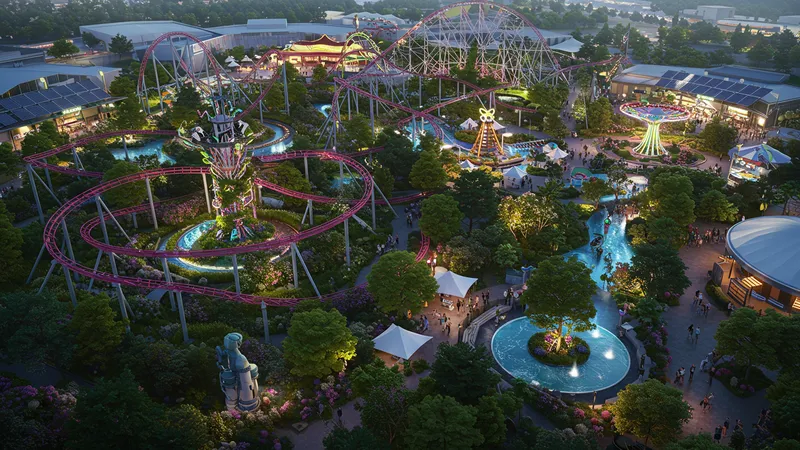
Ride materials, waste management, and park expansions still challenge environmental sanctity. Innovative solutions often grapple with higher costs, even as guest demand forces change. Many parks are experimenting with renewable energy sources, aiming for carbon neutrality within ambitious timelines. However, retrofitting existing infrastructure for greener operations remains costly and complex, leaving stakeholders weighing costs against long-term benefits. As governmental pressures tighten, achieving sustainability is imperative.
Guest awareness initiatives merge engagement with education. By integrating conservation messages within attractions and educational experiences, parks cultivate environmental stewardship among visitors. This approach connects planetary well-being with personal enjoyment, inspiring behavior change. Such efforts symbolize a potential future where entertainment and environmentalism coexist harmoniously, benefiting all. But it’s the technology underpinning these initiatives that could lead the way.
Emerging green technology offers hope in this balancing act, although its adoption varies across the industry. Innovations like energy storage advancements and environmental monitoring systems could soon redefine operations entirely. Real-time data guides proactive decision-making, optimizing ride cycles during off-peak hours to conserve power. Although promising, scaling these solutions remains an expensive proposition, tempered by their potential for widespread impact. Partnerships might accelerate progress, but what’s next in this realm is truly game-changing…
Technology is the backbone propelling modern amusement parks. From AI-driven experiences to augmented reality integrations, tech-savvy approaches are poised to reshape the industry. Advanced algorithmic designs are not just personalizing experiences but perfecting rides for taller, faster, and safer enjoyment. These innovations also heighten excitement, promising thrills previously unimaginable while ensuring rides meet contemporary safety standards—however, the technological frontier extends further.
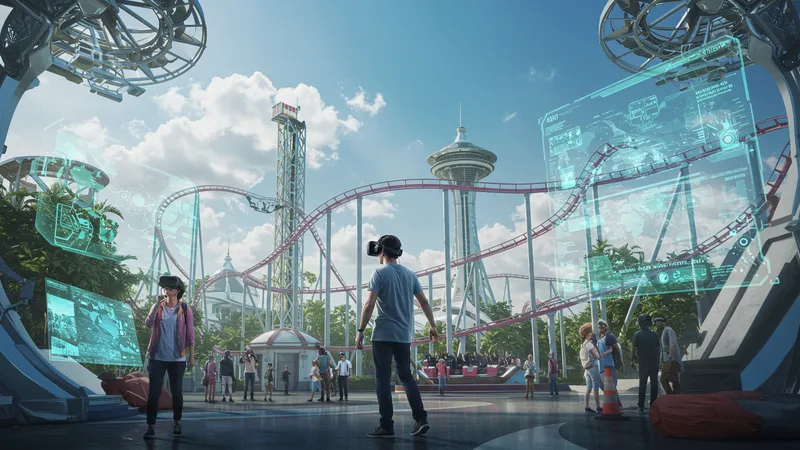
Virtual Reality is breathing new life into classic rides. This transformational twist immerses guests in hyper-realistic scenarios, enhancing sensory connectivity beyond traditional physical limits. Projects under development include multiverse concepts where guests “travel” between realities, experiencing utterly unique sensations. Although implementation remains costly, its popularity indicates a burgeoning trend. But as these hyper-realistic dreams unfold, real-world implementation faces numerous challenges.
Critics cite potential overstimulation and detachment as possible issues VR and AR might bring alongside amusement. Maintaining authentic personal connections in increasingly visual experiences could diminish shared enjoyment, reducing the social interaction that rides currently foster. Conversely, proponents argue these technologies enhance cognitive engagement levels, offering sharper mental stimuli. Such varied expectations are exacerbated by rapid digital evolution, placing amusement parks at the cusp of revolutionary advancements.
Integrating robotics into routine operations is another upcoming facet. From automating ticketing to enhancing ride safety, robotics could streamline processes, freeing human resources for more personal guest interactions. Attractions like robotic performers might add novel entertainment layers never before explored. While futuristic, these elements require sophisticated ethical frameworks to balance technology integration with guest privacy concerns, cementing an exciting yet responsible foundation for the future. Exploring consumer impacts further highlights technology’s role in this narrative…
The thrill of amusement parks extends into the realm of consumer psychology, where marketing strategies fuel emotional connections. Parks craft narratives around rides, branding them with promises of unforgettable memories. This emotional storytelling plays into consumer desires for unique and meaningful adventures, often compelling visits through anticipation and excitement. Yet it’s how these experiences translate into tangible consumer behavior that’s truly intriguing.
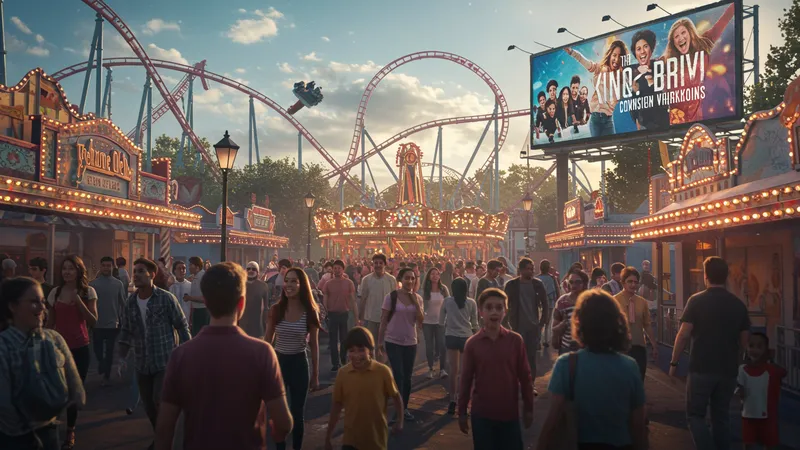
Return visits are often rooted in the emotional highs experienced during initial encounters. The nostalgia associated with exhilaration and joy fosters loyalty and generates word-of-mouth buzz, vital in a competitive landscape. Moreover, parks capitalize on experiential marketing, transforming ticket buyers into brand ambassadors. This emotional investment drives sustained interest and visitation beyond mere product consumption. But how it interacts with digital engagement secures enduring relevance.
Digital platforms amplify these connections, allowing parks to remain at the forefront of consumers’ minds. Social media and personalized marketing campaigns create behind-the-scenes intrigue, building anticipation before new ride debuts or events. These interactions offer an ongoing relationship, fostering deeper affiliations beyond physical visits. Innovations extend toward virtual identification experiences, enhancing these emotional bonds exponentially, offering competitive advantages unlike ever before encountered.
Despite these benefits, digitalization challenges traditional consumer engagement methods, forcing a recalibration of guest expectations. Maintaining charm and exclusivity amid digital oversaturation is demanding yet crucial. However, steadfast stewardship over digital personas can inspire significant loyalty, reflecting how storytelling, emotion, and technology intertwine to fuel amusement park success continually. The broader ramifications extend further, highlighting industry trends that remain key to its future promise…
The amusement park industry is continuously evolving, adapting global trends into its framework for sustained allure. Cross-cultural integration is becoming more pronounced, with parks embracing diverse themes that mirror global cultures. These efforts are evident in emerging markets like Asia, where rapid growth demands cultural innovation. Emulating successful strategies and localizing attractions broadens market appeal, yet adds challenging layers of complexity to park operations.
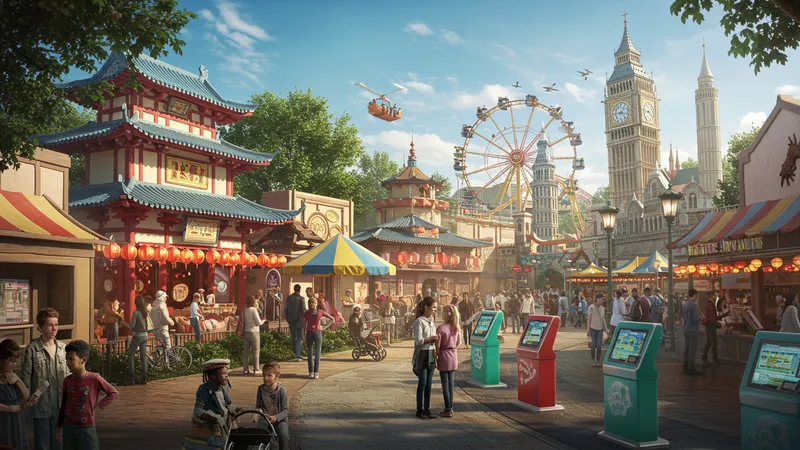
Customization becomes vital as global guest expectations diversify. Parks now offer a range of customizable experiences to cater to differing tastes, capitalizing on personalization while boosting visitor satisfaction. Intelligent use of consumer data combined with regional trend analysis predicts individual needs, enabling tailored experiences like never before seen. But as customer demands evolve, so must brand adaptability, with identity becoming fluid and responsive.
Brand expansions have seen major parks investing heavily in intellectual property acquisitions, aiming to transform beloved franchises into experiential adventures. This symbiotic branding establishes powerful affiliations between media and nature, leveraging franchise popularity for new park spectacles. Although beneficial, IP partnerships present inherent risks of brand dilution should public interest wane. Yet, a balanced approach remains crucial as brands seek to expand global footprints effectively.
Amusement parks’ future promises continued adaptation, with creativity and cultural sensitivity cornerstones for sustained success. Yet emerging challenges will demand foresight; environmental sustainability, digital disruption, and technology management will remain critical in preserving relevancy. Amidst changing backdrops, navigating human emotional resonance, enriching experiences, and embracing cultural subtleties fosters potential relevance in this competitive domain. What unfolds next marks a pivotal moment in entertainment history, but looking back at cultural evolution holds lessons…
The cultural evolution of amusement parks showcases an intriguing journey. Initially developed as leisure entities, they evolved into complex cultural symbols embodying freedom, joy, and innovation worldwide. The carousels of yore, once humble entertainment offerings, have metamorphosed into today's sophisticated amusement wonders aiming for comprehensive experiences. Yet, this evolution didn’t happen overnight—with each step intertwining closely with societal changes.

Early parks reflected prevailing social structures and aspirations, serving as escapist fantasies for traditional roles initially. Shows depicting fantastical worlds offered mass public entertainment, shaping early perceptions of broad imagination yet celebration amidst post-industrial expansion. As society progressed, attractions adapted, embracing technological smarts while engaging society's changing ethos. Evolving along established norms was pivotal—offering futuristic diversions in sync with emerging ideals.
Modern parks emphasize diversity, promoting inclusive experiences that celebrate cultural convergence amidst globalization. Themed attractions, reminiscent of varied international traditions, reflect this trend vividly among contemporary offerings. Accessibility improvements for physical and cognitive inclusivity highlight growing attention toward universal enjoyment. While designs may differ, the truth remains—accessibility ultimately enables true industry progress beyond anticipation.
Cultural perceptions of amusement parks continue evolving alongside contemporary ideas. Leveraging historical perspectives provides vital insight into how playful entertainment reshapes consumer perception, informed by education and curiosity across generations. Examining cultural history exposes inspirations defining much of today's creative landscape enveloping modern amusement culture worldwide. The era ahead holds potential as reflections unlock deeper insights, but what’s next will surprise everyone in this continuing entertainment saga…
Amusement parks play a multifaceted role in today’s society, extending beyond mere entertainment services. As symbols of escapism, they provide communal spaces fostering social interaction, families, and friendships. Throughout history, they’ve offered spaces where societal norms temporarily soften, embracing freedom amidst unique, imaginative settings. Yet this jubilant escape provides more than momentary delight by impacting perceptions profoundly.
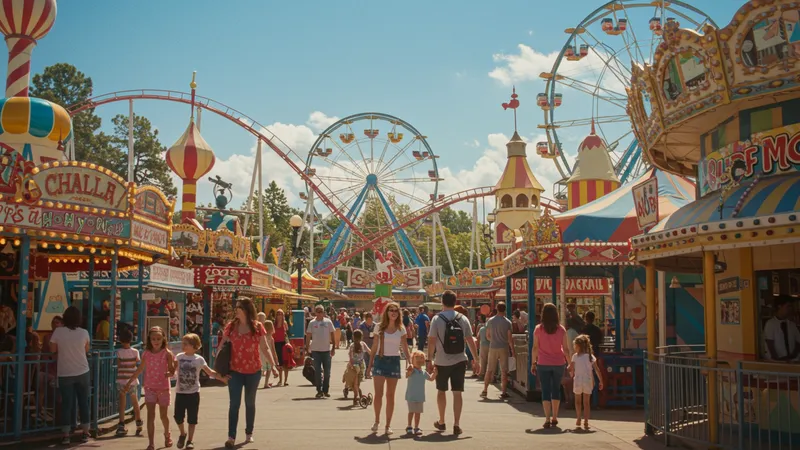
Enduring park experiences often connect emotionally, resonating long after visits conclude. This emotional connection influences perceptions, imbuing joy and wonder ingrained alongside cultural consciousness. These awe-inspiring moments often become family treasures, passed across generations, influencing myriad social attitudes. Consequently, parks serve as essential repositories for preserving memories young and old alike, that deepen familial bonds, fostering communal joy worldwide.
Additionally, their influences stretch into economic spheres, reflecting community priorities while driving localized development. The era of socio-economic turbulence underscores domestic tourism networks’ resilience, highlighting parks as central in regional recoveries from downturn effects. By driving tourism while advancing responsible initiatives, amusement enterprises shape local identities while forging global footprints, central to continuity amidst shifting challenges.
Now, contemporary discourse positions them uniquely between educational and entertainment paradigms. Educational applications extend beyond traditional confines, tapping dynamic methods encouraging skill development across diverse fields. These forums inspire brainstorming innovations, illustrating new learning methods within stimulating environments. Parks increasingly assume dual roles bridging entertainment-education divides, preparing the future landscape successfully anchored upon continuing societal development trends. Moving forward, these interactions shape promising possibilities through sustained communal impact…
Amusement parks mirror broader cultural identities, influenced strongly by socio-cultural dynamics shaping visitor interactions. Explorations within these spaces reflect evolving cultural trends while weaving new sociological narratives. Crowds amplify rides’ essence by bringing collective cultures, traditions, and desires, enhancing shared suspense within collective journeys. This communal participation fosters constancy—uniting myriad individuals through mutual anticipation, joy, and ultimate satisfaction.

Amusement parks serve essential roles in defining social cohesion while advancing sociological understanding. Observing diverse interactions within these joyous spaces illustrates societal structures and transformations. Reflecting cultural syncretism, they increasingly accommodate varying demographic backgrounds through inclusive experiences resonating diversely amid ever-changing multicultural societies. By tailoring attractions, narratives amplify social nuances amid harmonious coexistence. But firmly rooted curiosity underlines underlying motifs shaping identities within overlapping dynamics.
Furthermore, these settings spotlight innovative thought amid societal engagement adaptations by recognizing diverse cultural contexts. Creative interpretations embedded into attractions mirror contemporary values, presenting inviting frameworks encouraging communicative dialogue reflective of broader cultural intersections. This deliberate engagement inspires future prospect advancements through insightful collaborative perspectives inclusive of myriad cultural expressions enriching emotional landscapes uniquely.
The enveloping influence extends far deeper than apparent amusement, nurturing appreciation transcendently aligned uniquely to universal enjoyment. Reflected through compelling narratives and connections spanning expectations, individualized insights materialize upon exploration beyond simplistic interpretations historically encountered. Observing cross-cultural ties unveils broad societal implications, unearthing nuances influencing societal legacies while expanding entertainment systems’ immense potential contributions. On this transformative journey, considering parks invokes possibilities beyond simplicity—voicing cultural harmony interactions pioneered historically from entertainment tales globally prevailing timelessly enticingly so…
The intricate thrill and exhilaration of amusement parks offer us more than just fleeting joy—they stand as a testament to human innovation and the timeless pursuit of happiness. As you reflect on the mind-bending twists and turns of these rides, consider how these marvels continue influencing society, inviting all to partake in this whirlwind of excitement. What a ride it has been! To ensure others can also feel this thrill, share these insights widely, bookmark for future referral, or even plan your next adventure to experience these wonders firsthand. We’re all part of this grand, adrenaline-charged story, so why not be the one to turn the next page?